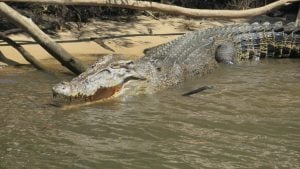Cruising along the serene East Alligator River
11 July 2015
Today we will travel in the coach to Ubirr to explore the galleries of ancient Aboriginal artwork. Our guide Phil has obviously done a great deal of research on rock art, and was helpful in understanding the paintings.
Our guide Phil, explains some of the rock art (right) and part of the Rainbow Serpent art work (left)
We had the opportunity of clambering up a rocky hill (hard work on a very warm day!) but we made it, and the climb was well worthwhile. The view across the plains was spectacular, this area is where the movie Crocodile Dundee was filmed.
The sandstone rocks are just amazing in their shapes, formations and patterns and they have been there for thousands of years.
We enjoyed another buffet lunch at the Kakadu Crocodile, a fairly new resort – seen from the air it is the shape of a crocodile! Then we drove to the East Alligator River to join the Guluyambi cultural cruise with our aboriginal guides, our guide was Robert. Again it was a beautiful warm day with a cloudless sky and Robert frequently turned off the engines as we drifted along the river, listening to the water lapping against the boat, the birds calling, and Robert’s soft voice telling us about the ancient culture and legends of the region, his life and his people, and his “backyard”, Kakadu.
 Robert told us about the different types of trees along the river, and how they are used in their day to day life. The prolific paper bark (Melaleuca) provides its bark to make plates, drinking vessels, and shelter, newborn babies are wrapped in the soft bark. The branches are used to make spears and woomeras – they are great recyclers! The Pandanas Palms (right) are used by the women to make baskets.
Robert told us about the different types of trees along the river, and how they are used in their day to day life. The prolific paper bark (Melaleuca) provides its bark to make plates, drinking vessels, and shelter, newborn babies are wrapped in the soft bark. The branches are used to make spears and woomeras – they are great recyclers! The Pandanas Palms (right) are used by the women to make baskets.
 Robert pointed out the Cane Grass that grows along the river banks, used by the crocodiles to form their nests. The trick for the crocs is to find the best spot for a nest, too close to the river and it will flood in the monsoon rains. Interesting that once the little crocodiles are born, they often provide meals for their parents, as well as other predators! Only a small percentage grow to adult size (thank goodness!)
Robert pointed out the Cane Grass that grows along the river banks, used by the crocodiles to form their nests. The trick for the crocs is to find the best spot for a nest, too close to the river and it will flood in the monsoon rains. Interesting that once the little crocodiles are born, they often provide meals for their parents, as well as other predators! Only a small percentage grow to adult size (thank goodness!)
As we cruised along the river we had Kakadu on one side, and Arnhem Land on the other, a pristine wilderness of 100,000 square metres of protected land, regarded as Australia’s last frontier. About 3,000 Aboriginal People live in Arnhem Land today and it is one of the few areas in Australia where they still live a traditional life and maintain a strong sense of cultural identity. We were permitted to get off the boat at one section of Arnhem Land but had to stay close to the where the boats were moored (crocodiles can go on to land too!!)
Robert demonstrated how the Aboriginal People use a woomera to throw their spears, and he was very accurate on land and throwing the spear over the water almost to the opposite bank.
There were some rocky areas that we were also permitted to climb on, quite steep but great views up and down the river, and for spotting more crocodiles.
Robert demonstrated how his people use natural materials to make their paints, and had a piece of red rock that he ground with some water, and the kids on board loved having their faces painted – the rest of us had a red daub on our hands!
We saw so many crocodiles during the cruise, mostly sunning themselves on the river banks, and finally we found Nigel, a large old crocodile who has had a tag for the last couple of years so his travels can be tracked.
It was sad to come to the end of the cruise, but time was moving along and we had three more sites to visit. The first was the Bowali Visitor Centre, which is the Management Centre for the Kakadu National Park. Here we saw many fine exhibits of life in Kakadu, and a finished off with a cold icecream from the Bowali cafe to cool us down on what turned out to be a very hot day!
Our next visit was to the Ranger uranium mine which is no longer active, but once employed a large workforce, although there were many protests about this mine. The mine owners are supposed to rehabilitate the site – but like many other mines, this won’t happen. It is sad to see the devastation caused by the industry.
The last site to visit was the Mamukala Wetlands which is a very pretty spot, but not many birds to be seen this time. So after a very full two days in Kakadu, the coach headed back to Darwin, and we prepared for a couple of half day tours tomorrow.
















